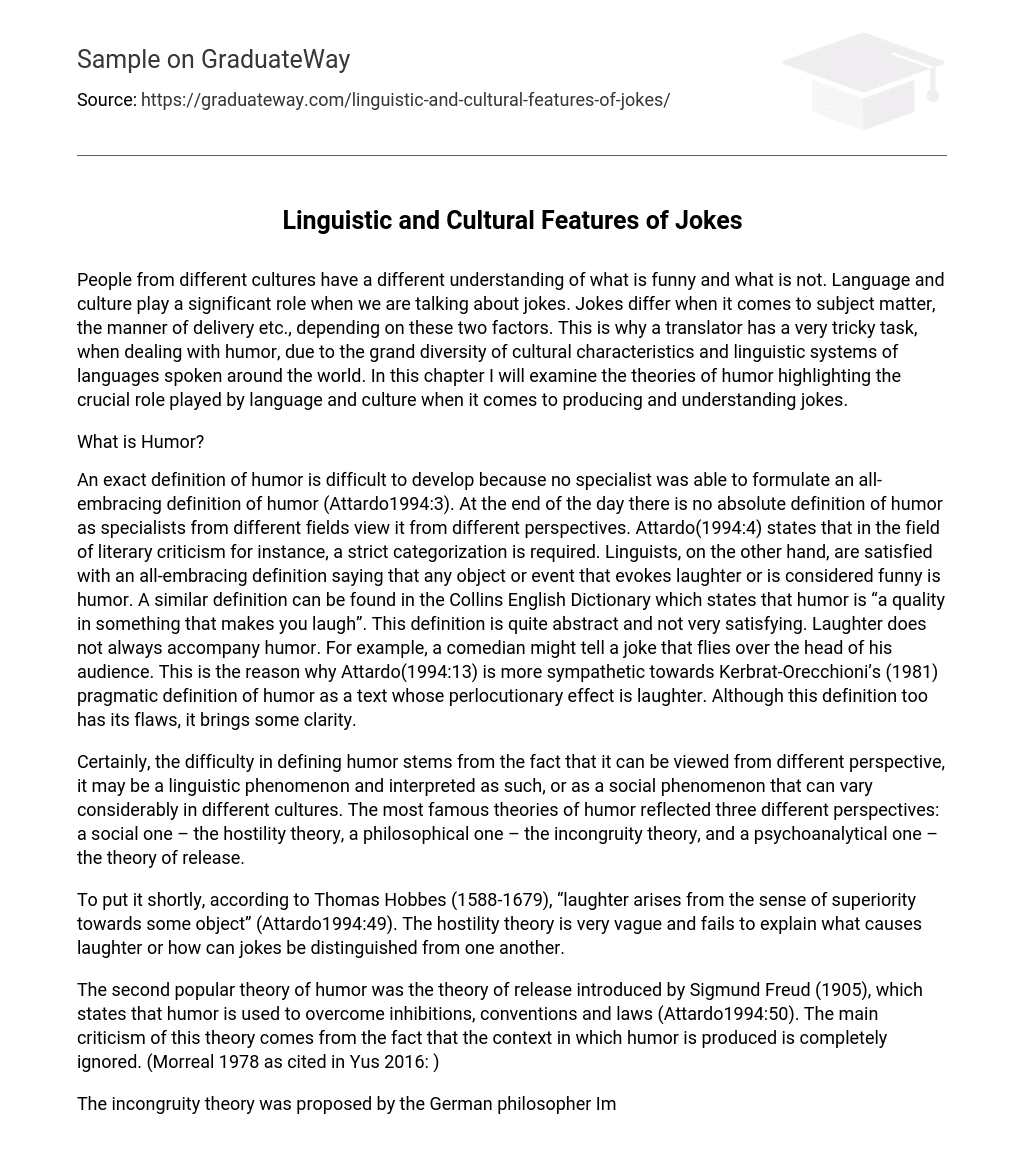People from different cultures have a different understanding of what is funny and what is not. Language and culture play a significant role when we are talking about jokes. Jokes differ when it comes to subject matter, the manner of delivery etc., depending on these two factors. This is why a translator has a very tricky task, when dealing with humor, due to the grand diversity of cultural characteristics and linguistic systems of languages spoken around the world. In this chapter I will examine the theories of humor highlighting the crucial role played by language and culture when it comes to producing and understanding jokes.
What is Humor?
An exact definition of humor is difficult to develop because no specialist was able to formulate an all-embracing definition of humor (Attardo1994:3). At the end of the day there is no absolute definition of humor as specialists from different fields view it from different perspectives. Attardo(1994:4) states that in the field of literary criticism for instance, a strict categorization is required. Linguists, on the other hand, are satisfied with an all-embracing definition saying that any object or event that evokes laughter or is considered funny is humor. A similar definition can be found in the Collins English Dictionary which states that humor is “a quality in something that makes you laugh”. This definition is quite abstract and not very satisfying. Laughter does not always accompany humor. For example, a comedian might tell a joke that flies over the head of his audience. This is the reason why Attardo(1994:13) is more sympathetic towards Kerbrat-Orecchioni’s (1981) pragmatic definition of humor as a text whose perlocutionary effect is laughter. Although this definition too has its flaws, it brings some clarity.
Certainly, the difficulty in defining humor stems from the fact that it can be viewed from different perspective, it may be a linguistic phenomenon and interpreted as such, or as a social phenomenon that can vary considerably in different cultures. The most famous theories of humor reflected three different perspectives: a social one – the hostility theory, a philosophical one – the incongruity theory, and a psychoanalytical one – the theory of release.
To put it shortly, according to Thomas Hobbes (1588-1679), “laughter arises from the sense of superiority towards some object” (Attardo1994:49). The hostility theory is very vague and fails to explain what causes laughter or how can jokes be distinguished from one another.
The second popular theory of humor was the theory of release introduced by Sigmund Freud (1905), which states that humor is used to overcome inhibitions, conventions and laws (Attardo1994:50). The main criticism of this theory comes from the fact that the context in which humor is produced is completely ignored. (Morreal 1978 as cited in Yus 2016: )
The incongruity theory was proposed by the German philosopher Immanuel Kant in 18th century. Kant’s famous definition of laughter reads “Laughter is an affection arising from a sudden transformation of strained expectation into nothing” (Kant 1790 as cited in Attardo 1994:48).
This theory is based on the idea that laughter is caused by the discrepancy between two ideas. In other words, according to this theory, humor occurs when a presented situation is resolved in an unexpected way.
Example 1:
Son: Is America far away?
Dad: Shut up and keep swimming!
In the joke presented above the first sentence presents the audience with could be part of a relaxed conversation between a father and his son on general culture. The resolution in the second line is absurd, as it suggests that they are crossing the ocean to arrive to America.
The incongruity theory was the basis for various theories developed by linguists to account for humor, which will be discussed in the following section.
Linguistic Theories of Humor
Regardless of the difficulties discussed above, several linguists have shown interest in the topic of humor. It will be helpful to look at the research done in the field to have a better understanding of this phenomenon. In his book “Theories of Linguistic Humor”, published in 1994, Salvatore Attardo, discusses various theories proposed by linguists which he divides into four categories: (a) structuralist theories; (b) semiotic theories; (c) sociolinguistic theories and (d) script-based theories.
Structuralist Theories
Structuralist theories have at their core the concept of isotopy introduced by Greimas in 1966. Isotopies (the sense) of the joke is established until it is negated by an element called disjunctor which can be encountered in the punch-line of the joke producing the incongruity (Attardo 1994 94-95).Puns where researched the most within the structuralist framework (Attadro 1994:108); According to Attardo (1994 113-114) Duchàcek (1970) has an extremely elaborate taxonomy of puns according to the linguistic phenomena involved: homonymy, polysemy, anatomy, morphemic attraction, tendency to motivate and contamination.
Semiotic Theories
These theories have at their core Koestler’s (1964) cognitive bisociation model. Koestler defines bisociation as “the perceiving of a situation or idea (…) in two self-consistent but habitually incompatible frames of reference” (1964, as cited in Attardo, 1994:175). In other words, “the bisociation occurs when an idea is understood from two frames of reference which are incompatible” (Yus 2016:76). The incompatibility of frames is illustrated in the following example (Yus 2016:76)
Example 2:
O’Reilly was on trial for armed robbery. The jury came out and announced “Not guilty”. “Wonderful” said O’Reilly, “does that mean that I can keep the money?”
Yus (2016:76) comments on the joke presented above saying that the punch-line is incompatible with the setup thus it is unclear if the person is actually guilty or not.
Sociolinguistic Theories
Sociolinguistic theories use discourse analysis when researching humor. Although Attardo (1994:296) mentions that it is difficult to distinguish between canned jokes and situational jokes, this division is used because a clear-cut division has an appeal to the majority of linguists. Both Harvey Sacks (1972) and Joel Sherzer (1978) have analyzed conversational puns (Attardo 1994:312) while Deborah Tannen made an attempt at studying conversational humor more in depth.





